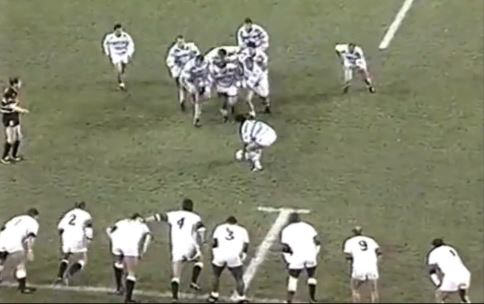Because flying wedges are illegal in rugby, you may never have seen one. However, there are some coaching tactics you’ll see that seem to be very similar.
This article will show you what a flying wedge looked like on a rugby pitch. We’ll explain why it’s illegal, and why other similar plays (like the rolling maul) are allowed.
What Is A Flying Wedge in Rugby?
The flying wedge usually involves the heavier forwards on the team.
The players form into a tight wedge and hold (or bind) onto each other. The entire wedge runs toward the opposition.
Crucially, the wedge doesn’t yet have the ball.
Here’s a still from some grainy footage from 1985. The move was played when a team was awarded a penalty or free-kick. In the picture, the scrum-half is about to tap the penalty kick. His forwards are already bound and moving towards the ball.

The laws of rugby mean that the opposition has to stay ten yards back until the ball is tapped or kicked. This gives the attacking wedge a good run to gather momentum from a standing start.
(This is what makes it illegal now).
When the wedge has momentum, the ball is tapped and passed to a player in the center of the wedge. The goal is that they have so much momentum, they can push through the defensive line and ground the ball for a try.
A televised example from the Rugby World Cup
Here’s a clip from an international match between Argentina and England in the 1995 Rugby World Cup.
The footage is a little grainy, but the formation is clear.
England are defending on their try line. The Argentinian wedge barrels through the defensive line and the try was awarded.
Where Did The Flying Wedge Come From?
The sport of rugby originated from older versions of “mob” football played in English towns and villages. There were very few rules.
There are descriptions of lines of men linking arms and rushing towards the opposition.
However, the first appearance of the flying wedge as a coached tactic is from 1892 in the United States.
Back then, American universities were playing a version of football that combined rules from what we now know as soccer and American football.
We have a full article on the history of the flying wedge in American football.
I’ll summarize it here. The football coach of Harvard was a disciple of Napoleon’s military strategies.

One of Napoleon’s tactics was to mass a large number of his troops against a weak point in the enemy line. This allowed the attackers to break through into the enemy’s rear and scatter them.
Coach Deland recreated this tactic on the college football fields as the flying wedge. It was quickly taken up through the 1890s by college coaches across the United States.
Carnage and death in America
The flying wedge was both successful and lethal. Just taking 1905, there were twenty-two fatalities and 150 serious injuries attributed to the play.
That’s insane! Why wasn’t it banned? Well, it took the intervention of President Theodore Roosevelt to outlaw the tactics.
What Are The Rugby Union Laws About The Flying Wedge?
The flying wedge is specifically named in the law books. The wording has changed from time to time as ingenious coaches try to bring
This is the current law, which isn’t very clear.
One law says: “Teams must not use the ‘cavalry charge’ or ‘flying wedge’.”
You need to check another section to find the explicit definition.
I’m going to quote it here, but don’t spend too much time puzzling over what exactly they are trying to say. The problem is that it’s both too detailed and too vague.
I suggest you jump to the next section in this article, in which I explain how referees interpret the laws.
Description in the law books

An illegal type of attack, which usually happens near the goal line, when the attacking team is awarded a penalty or free-kick.
The kicker taps the ball and starts the attack, either by driving towards the goal line or by passing to a teammate who drives forward.
Immediately, team-mates bind on each side of the ball-carrier in a wedge formation before engaging the opposition.
Often one or more of these teammates is in front of the ball-carrier.
World Rugby Laws
Why Is The Flying Wedge Penalized In Rugby?
Two of rugby’s major principles are to prevent dangerous play and to allow a fair contest for the ball.
The flying wedge fails on both counts.
Dangerous play
We’ve already seen that it was responsible for many deaths in American football in the early 20th century.
There were less dramatic occurrences in rugby. However, concern grew in the 1960s and 70s about a rising rate of spinal injuries. This was at the same time as the tactic became more popular when a penalty was awarded near the opposition try line.
The flying wedge was more prevalent in lower-grade amateur rugby. At elite level, teams were more likely to kick for goal when they got a penalty near the try line. This is because the defensive lines were more organized.
Teams at lower levels got more change from giving up a chance for three points to run the flying wedge over the opposition line.
The rugby authorities recognized that the danger was coming from a bunch of forwards binding to each other and running forward to defenders stuck on their try line.
Referees were told to penalize this out of the game. They did this so well that by the 2000s, younger players and referees had never seen it on the pitch.
Fair contest for the ball
Blocking opposition would-be tacklers is a big part of American football. We have an article on how blocking is strictly forbidden in rugby (although the article shows a few grey areas).
Referees ensure that the defending team is allowed to contest for the ball.
During the flying wedge, the ball-carriers teammates are protecting them from being tackled.
The crucial point is that the teammates have bound to the ball carrier before they’ve engaged with the opposition. This is clear in the video clip of Argentina that I linked to earlier.
This is called obstruction in rugby laws, and it’s a penalty kick against the team in possession.
Why Aren’t Rolling Mauls Considered Flying Wedges?
Rolling mauls are a common play from a lineout.
The ball is thrown in and the hooker runs around the back of the line to collect the ball from the catcher.
The hooker tucks himself at the back of the bunched group of forwards who rumble forward towards the opposition line.
But wait! Isn’t that a flying wedge?
Well, no. The flying wedge involves the bunched group of forwards having a “free” run-up to gather momentum before they hit the opposition line.
In contrast, the defenders were also in the lineout and are in the faces of the ball-carrier and his teammates. They don’t get an unfair opportunity of generating momentum from a distance.
This removes the dangerous play element from rolling mauls.
What about obstruction?
There’s no doubt that the opposition are obstructed from competing with the ball during a rolling maul.
There are plenty of rugby fans who think mauls should be kicked out of the game. Sometimes, the most vocal opponents of the maul are fans of teams whose forwards are less powerful than their competitors.
I’m joking. A little! But it can be really boring when it’s the only tactic employed close to the line.
However, the laws of rugby are written in a way to prevent flying wedges but to allow rolling mauls.
If you want to get into the more technical detail, check out our article on mauls and rolling mauls in rugby.